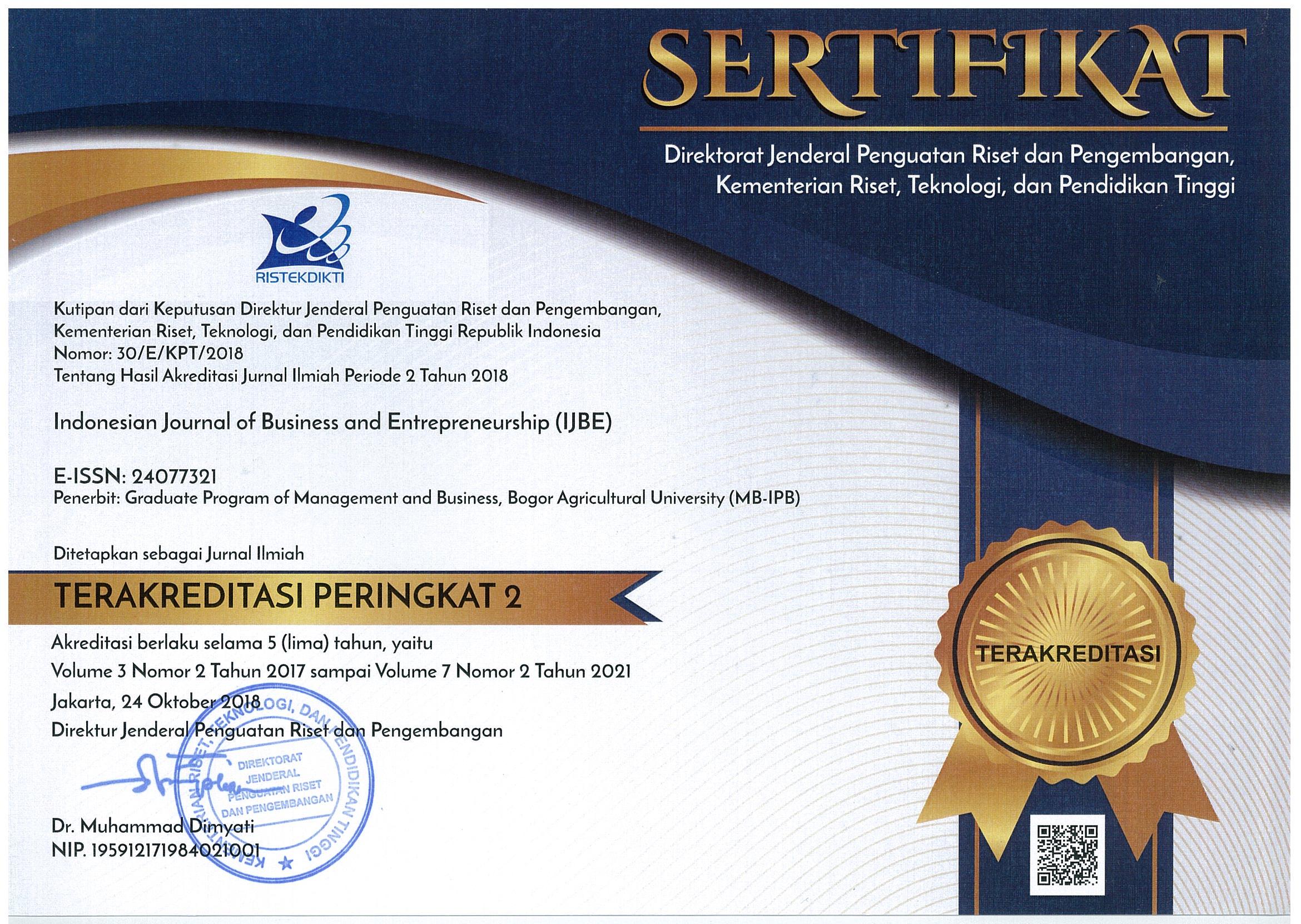DEVELOPING "SEKOLAH PETERNAKAN RAKYAT" PROGRAM USING THE BUSINESS MODEL CANVAS APPROACH (CASE STUDY: BOJONEGORO REGENCY)
Abstract
SPR Maju Bersama is one of the location where the concept of "Sekolah Peternakan Rakyat (SPR)" is implemented, with the aim to encourage small-scale beef cattle breeder establish a professional collective enterprise under one management. SPR is designed to change the mindset, knowledge and capability of the beef cattle breeder to become the best and self-reliant entrepreneurs in the beef cattle business. In the effort to achieve its objective, the organization has not been able to carry out the model business effectively thus new strategies are needed to improve the business model. The objectives of this research are: 1) identify the present business model carried out by SPR Maju Bersama; 2) to carry out SWOT evaluation on each element of the business model; 3) formulate strategic to improve the business model that is formulated in an accurate programs. This research used the combination of business model canvas (BMC) approach and SWOT matrix analysis. The results it is concluded that the SPR Maju Bersama need to improve the business model through alternatives strategies that have been developed include: 1) increase the number of farmer members; 2) apply the concept of "agrosilvopastura" to optimize the management of natural resources; 3) increase the intensity of assistance through e-learning; 4) improve the quality and intensity of the relationship between management and farmers; 5) develop curricula, programs and guide books as well as strengthen the system of membership; 6) expand the partnership by utilizing information technology and existing business partners; 7) establish training centers and services as a resource in the field of SPR and beef cattle; 8) utilizes a strong partnership to change the mindset of farmers; 9) increasing leadership skill and the ability to use communications technology in the management of SPR.Keywords: sekolah peternakan rakyat, Bojonegoro, BMC, matrix SWOT
Downloads
References
Abdelkafi N, Makhotin S, Posselt, T. 2013. Business model innovations for electric mobility-what can be learned from existing business model patterns? International Journal of Innovation Management 17(1): 1340003. http://dx.doi.org/10.1142/S1363919613400033.
Andrews M, Goehring J, Hui S, Pancras J, Thornswood L. 2016. Mobile promotions: A framework and research priorities. Journal of Interactive Marketing 34: 15–24. http://dx.doi.org/10.1016/j.intmar.2016.03.004.
Apăvăloaie EI. 2014. The impact of the internet on the business environment. Procedia Economics and finance 15: 951–958.
Bell, Simon J, Seigyoung A, Karen S. 2005. Customer relationship dynamics: service quality and customer loyalty in the context of varying levels of customer expertise and switching costs. Acedemy of Marketing Science 33 (2): 169 –183.http://dx.doi.org/10.1177/0092070304269111.
Bokor J. 2011. Universitas at risk in a demand driven market: Einst & Young study, Ernst & Young. http://www.ey.com. [3 Maret 2016].
[BPS] Badan Pusat Statistik. 2013. Data Sensus Pertanian 2013. Jakarta: BPS.
Carayannis EG, Barth TD, Campbell DF. 2012. The Quintuple Helix innovation model: Global warming as a challenge and driver for innovation. Journal of Innovation and Entrepreneurship 1(1):1–12. http://dx.doi.org/10.1186/2192-5372-1-1.
Carayannis EG, Campbell DF. 2009. ‘‘Mode 3’’ and ‘‘Quadruple Helix’’: Toward a 21st century fractal innovation ecosystem. International Journal of Technology Management 46(3–4): 201–234. http://dx.doi.org/10.1504/IJTM.2009.023374.
Carayannis EG, Campbell DF. 2010. Triple Helix, Quadruple Helix and Quintuple Helix and how do knowledge, innovation and the environment relate to each other? A proposed framework for a transdisciplinary analysis of sustainable development and social ecology. International Journal of Social Ecology and Sustainable Development 1(1): 41–6. http://dx.doi.org/10.4018/jsesd.2010010105.
Carayannis EG, Sindakis S, Walter C. 2014. Business model innovation as level of organizational sustainability. Journal of Technology Transformation 40: 85–104. http://dx.doi.org/10.1007/s10961-013-9330-y.
Casadesus MR, Ricart JE. 2010. From strategy to business models and onto tactics. Long Range Plan 43: 195–215. http://dx.doi.org/10.1016/j.lrp.2010.01.004.
Chesbrough H. 2010. Business model innovation: Opportunities and barriers. Long Range Planning 43(2–3): 354–363. http://dx.doi.org/10.1016/j.lrp.2009.07.010.
Hill P. 2012. The search for differentiated and engaging student experience. http://mfeldstein.com [20 Maret 2016].
Johnson MW. 2010. Seizing The White Space: Business Model Innovation for Growth and Renewal. Boston: Harvard Business Press.
Kastelle T. 2012. Eight models of business models, and why they are important. http://timkastelle.org. [15 Oktober 2015].
Kariyana IK. 2014. Economic impact assessement of integrated crop management farmer field school program on corn production in Indonesia. International Journal of Food and Agricultural Economics 2 (4): 13–26.
[LPPM IPB] Lembaga Penelitian dan Pengabdian kepada Masyarakat Institut Pertanian Bogor. 2015. Buku panduan sekolah peternakan rakyat (SPR 1111). Bogor: Institut Pertanian Bogor.
Machacha A. 2008. Farmer field schools in Bungoma District of Western Kenya: A rapid appraisal [tesis]. Perancis: Iowa State University.
McGrath RG. 2010. Business models: A discovery driven approach. Long Range Planning 43(2–3): 247–261. http://dx.doi.org/10.1016/j.lrp.2009.07.005.
Musaeva K. 2015. Research organizations and business: interaction barriers in the context of innovative development. Social and Behavioral Science 214: 201–211. http://dx.doi.org/10.1016/j.sbspro.2015.11.663.
Osterwalder A, Pigneur Y. 2010. Business Model Generation. New Jersey: Wiley.
Osterwalder A, Pigneur Y. 2014. Business Model Generation. Terjemahan: Sihandrini NR. Jakarta: PT Elex Media Komputindo.
Rangkuti F. 2011. SWOT BALANCE SCORECARD: Teknik Menyusun Strategi Korporat yang Efektif plus Cara Mengelola Kinerja dan Risiko. Jakarta: PT Gramedia Pustaka Utama.
Rosenberg MJ. 2001. E-learning: Strategis for Delivering Knowledge in The Digital Age. New York: McGraw-Hill Education.
Shafer SM, Smith HJ, Linder JC. 2005. The power of business models. Business Horizons 48(3): 199–207. http://dx.doi.org/10.1016/j.bushor.2004.10.014.
Tian X, Martin B. 2012. Business models for higher education: an Australian perspective. Journal of Management Development 33 (10): 932–948. http://dx.doi.org/10.1108/JMD-06-2012-0075.








